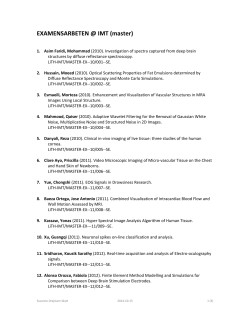
Document 427401
Hydra: an HTML5-based application for highthroughput visualization of ligand docking Yuan Zhao1 and Jason Haga2 of Bioinformatics, University of California, San Diego, CA 2Information Technology Research Institute, AIST, Tsukuba, Japan 1Department Summary Hydra is an HTML5-based application for high-throughput visualization of molecular docking simulations. Unlike existing solutions, Hydra’s implementation is platform agnostic, and therefore can be deployed quickly and cheaply across various hardware configurations. Additionally, it is designed with an intuitive interface that is scalable with respect to screen sizes, ranging from mobile devices to large, tiled display walls (TDWs). Motivation To develop an easy-to-use software solution that overcomes disadvantages inherent in existing platforms, such as: - Non-intuitive graphical user interfaces - Highly specific platform and set up requirements - High costs of hardware implementation and poor mobile accessibility Technical Details Schematic of Hydra Software Workflow Upload Molecular Docking Data Configure Hydra UI SeDngs Mobile Devices iview / Webix Front End Desktops / Laptops Tiled Display Walls Hydra Server Figure 1. Uploaded docking data files and user settings are sent to the Hydra application server, where the data are parsed and passed to the iview module. The resulting visualization and UI can be accessed through a wide range of hardware devices and scales to screen size. Hydra User Workspace Upload molecule data to the Hydra tool Select highlighted compounds from the list of uploads Unobtrusive live noIficaIons 2 1 Development Platform: HTML5 The HTML5 platform allows for the development of web-based applications that require zero end-user setup in order to use. This approach allows users to access the app anywhere that they have internet access, from all manner of devices irrespective of operating system, screen size, or form factor. UI Framework: Webix Webix1 is a library of modular, lightweight Javascript-based user interface elements. The resulting Hydra UI is interactive and intuitive to use, and can scale to virtually any screen size, giving users the flexibility to adapt their analysis and screening workflow to their hardware. Visualization Tool: iview iview2 is a molecular viewer for proteinligand complexes, based on the GLmol3 molecular viewer platform and built in WebGL/Javascript. It does not require plugins, installation or configuration, thus reducing setup requirements. Planned Features - Ability to flag/tag compounds and export compound lists - UI user testing and performance optimizations - Bring rich functionality on par with existing software like ViewDock TDW4. 3 4 Collapsible module panels Configure central visualizaIon module by choosing viewer grid size and assigning molecules to each viewer in the grid Central visualizaIon module The number of molecular viewing panels can be changed in the control panel via the “Grid Size” opIon View specific details on the selected compound Figure 2. The above mockup shows UI layout, design, and functionalities based on the current prototype build. (1) Data are uploaded via the “Import Compounds” panel. (2) The compound list allows uploaded files to be selected and (3) details of the selected file can be viewed in the third panel. (4) The control panel allows for the configuration of the central visualization module to be able to view multiple protein-ligand interactions in a single area. Sample molecules shown are of 4MBS, MOL2, SSH1, and a sample ligand in clockwise order. References 1. Webix. http://webix.com/ 2. H Li, KS Leung, T Nakane, MH Wong. iview: an interactive WebGL visualizer for protein-ligand complex. BMC Bioinformatics. 2014. 3. GLmol. http://webglmol.sourceforge.jp/index-en.html 4. CD Lau, M Levesque, S Chien, S Date, J Haga. ViewDock TDW: highthroughput visualization of virtual screening results. Bioinformatics. 2010. edinburgh data.intensive research Acknowledgements The authors of this project would like to thank the Partnership in International Research (PIRE) program, the Open Science Data Cloud (OSDC), the National Institute for Advanced Industrial Science and Technology (AIST), and the NSF for their support. Additionally, we thank Dr. Isao Kojima, Dr. Bob Grossman, Dr. Heidi Alvarez, Vasilka Chergarova for their guidance and hospitality.
© Copyright 2025















